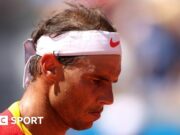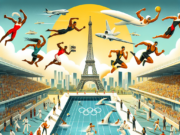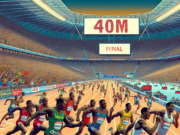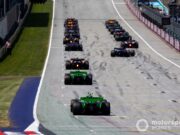The renowned French author Victor Hugo likened the prospect of dying in Paris to experiencing vertigo. “Nothing is more fantastic,” he noted. “Nothing is more sublime.” This sentiment feels particularly applicable on the opening day of the Paris 2024 Olympics, as you endeavor to navigate the array of venues through a downpour.
The inaugural day of the Paris Olympics unfolds with limitless opportunities, as the misty dawn breaks and the city stirs to life following the soggy celebrations of the opening ceremony. Forget about long, uncomfortable shuttle rides through unappealing suburbs to a pricey new stadium. Instead, a swift trip on the Paris Métro propels you to the heart of the City of Light, which – at least on paper or Google Maps – is conveniently close to many Olympic locations. Could it possibly be accomplished on foot? Paris is compact! It’s incredibly walkable! Just a brief stroll along the river or a quick hop on a complimentary city bike and—oh.
Attendees at Paris 2024 will need to quickly absorb some hard truths. Think you know this city? Think again. Assume Google Maps will guide you correctly? It might not. Believe that officials in Paris 2024 uniforms can provide accurate directions? Dans tes rêves, mon ami.
The Paris 2024 organizers have adopted an entirely fresh approach to these Games, pledging no white elephants or economically unfeasible stadiums that would be abandoned to any passing football team seeking a new residence. The major athletics events will occur at Stade de France, the nation’s flagship stadium, while 15 Olympic and 11 Paralympic venues are situated in existing structures throughout the city. Looking for fencing? What better location than the exquisite art-nouveau Grand Palais? In terms of archery, how about the historical Les Invalides? And beach volleyball? That must be played beneath the shadow of the Eiffel Tower.
In reality, this means Paris itself functions as the Olympic Village. A village where the typically manageable exterior security checkpoint is replaced by an unending series of Paris 2024-branded barriers, countless bag inspections, and seemingly every security guard and police officer in France on duty.
This reimagined Paris features roads transforming into paths that meander into barriers—often closed and manned by guards, volunteers, or police officers—whose guidance is as useful as a Frenchman’s vow of fidelity. However, this situation arises in a country that has endured numerous terrorist attacks and has witnessed youth tragedies in its streets—it is understandable why they won’t take any risks.
The day kicks off smoothly as eager crowds defy the rain and emerge from the Métro at Invalides, heading towards the Pont Alexandre III, past the still-drenched seating areas from the opening ceremony along the Seine, en route to the fencing events at the Grand Palais.
Constructed for the Universal Exhibition in 1900 and dedicated “by the French Republic to the glory of French art,” it stands as one of the most spectacular Olympic venues in modern Olympic history. Inside, its celestial iron and glass ceiling is covered with white tarpaulin to prevent natural light from distracting the competitors, but nothing can obstruct the spinning currents of its staircases, providing a dynamic backdrop to the foils’ jabs on the playing field. A small boy, his cheeks adorned with the tricolor, watches with rapt fascination. “He fences at a local club,” his father explains. “So being here is incredibly special for him.”
From the Grand Palais, it’s a brief 15-minute walk to Place de la Concorde, home to the Parc Urbain, where 3×3 basketball, street and park skateboarding, BMX freestyle, and the latest Olympic sport, breaking, are featured. However, this journey actually takes approximately an hour and a half due to an irritable exchange with a senior security officer, numerous dead ends, and multiple blocked roads.
The venue occupies a significant portion of the Jardin de Tuileries at the Louvre’s base, where the newly lit Olympic cauldron burns brightly from sunset until 2 a.m. Yet, on opening day, it remains firmly grounded. Beyond the barricade keeping neck-stretching visitors at a distance, streams of steam ascend into the air as the rain hits the eternal flame. Foiled from getting a closer look, bystanders raise their phones over the barriers, subsequently peering down at their minuscule screens. One man jumps restlessly to catch a glimpse. “Can’t see a thing,” he mutters.
after newsletter promotion
Regardless, the Parc Urbain appears deserted. The rain, which has transitioned from a gentle summer drizzle to a continuous downpour, has rendered the half-pipes of the street arena dangerously slick, postponing the men’s street skateboard event until Monday. Onward!
A few stops along the dual-tier RER C beside the Seine lead to the golden dome of Les Invalides, originally a retirement home for veterans, now a group of museums and, during these Games, the site of archery, the marathon finish line, and the starting location for the road cycling time trials. Cheerful yet damp crowds gather along the route, beneath the gilt-winged horses atop the Pont Alexandre III. “Allez, allez!”, they shout as the female competitors speed by, their eyes fierce with concentration. Among them, Great Britain’s Anna Henderson, celebrating her silver medal on her Olympic debut.
Next, another brief trip along the Seine brings the adventurous Olympics enthusiast to the crowning jewel of this extraordinary event: the sandy beach volleyball courts situated beneath the Eiffel Tower, constructed as the centerpiece for the 1889 Paris Exposition to celebrate the 100th anniversary of the French Revolution. The Champ-de-Mars public park, perhaps Paris’ prime relaxation area, has been replaced by open temporary seating, filled with fans clad in various shades of plastic ponchos on this opening day. Nevertheless, a DJ energizes the atmosphere with vibrant music, as athletes and spectators remain undeterred by the rain, cheering exuberantly for the players.
The iconic landmark looms majestically overhead as the celebration continues below. Like the city it symbolizes, it remains indifferent to whether spectators are present, how tiring navigating its streets may be, or whether medals will be awarded. Once the scaffolding is taken down, barriers removed, and police return to their communities—Paris will endure. Regardless of the Olympics, we will, for sure, always have Paris.



































